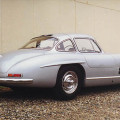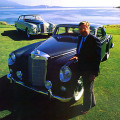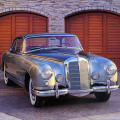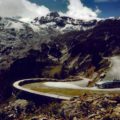What happens when the driver’s door pops open on a 300SL— at 150 mph? For everyone except Don Ricardo, that’s a purely hypothetical question.
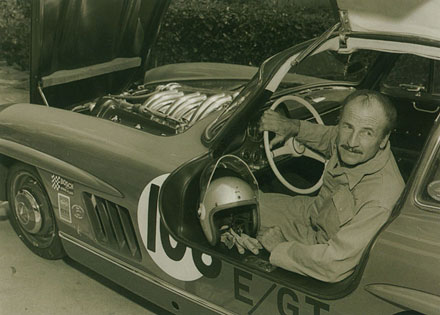 In 1967, during a record run at Bonneville, that’s exactly what happened to him. Vibration freed the latch, and as the dry salt bed flashed by in a hot, white glare, the door suddenly flew open with a deafening roar, its support struts held, and the entire left side of the gullwing Mercedes-Benz left the ground.
In 1967, during a record run at Bonneville, that’s exactly what happened to him. Vibration freed the latch, and as the dry salt bed flashed by in a hot, white glare, the door suddenly flew open with a deafening roar, its support struts held, and the entire left side of the gullwing Mercedes-Benz left the ground.
Fate was with Ricardo that day. He managed to keep the car going straight, resisted the impulse to hit the brakes, and let the speed evaporate until the car dropped back onto all four wheels. What could have been a disaster was nothing more than a harrowing experience for the then 59-year old Ricardo. He drove back to the staging area, tied the door closed with rope, and went back out to set a Class E, Grand Touring Sports Class record of 153.771 mph for a two-way trip through the measured mile.
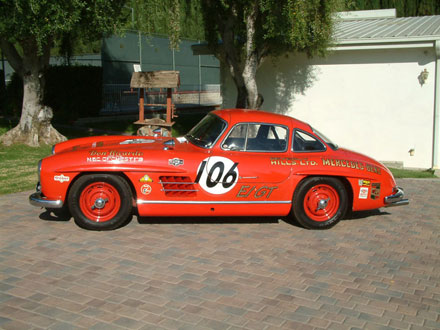
Looking Back
Now, 31 years later, Ricardo is behind the wheel of the very same car, driving the somewhat less than street-legal vintage Bonneville Mercedes-Benz along the streets of Pasadena.
“I still love driving this car,” says Ricardo, now 90-years old, “but it’s a lot harder to get out of than it used to be!” he laughs, flashing the same broad grin he had when he clambered out of the alloy-bodied gullwing’s cockpit in 1967.
What could have driven someone almost 60 years old at the time to challenge a Bonneville record in a 12year old, untried car?
“Well, you kind of grow into it,” says Ricardo, as he sits in the den of his Pasadena home across from a museum-sized trophy case filled with plaques, ribbons, and trophies proclaiming past victories. “I’d been racing dirt track motorcycles, competing in road races and drags for years, so this was next. I’ve always liked going fast, always liked speed. It was a thrill, and you don’t stop and think you might get killed. You just keep going.”
Don is probably the best known and most respected MBCA member, a man whose name has in his lifetime become synonymous with the 300SL and Mercedes-Benz. Still, of all his achievements he is most proud of his run at Bonneville, setting a record that has never been broken.
Always a Competitor
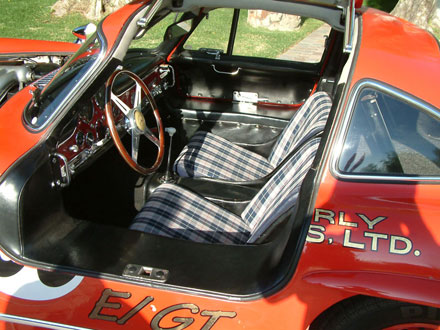 Back in the 1950s, Don was racing a Jaguar XK-120M after owning a string of post-war MGs and a Jowett Jupiter.
Back in the 1950s, Don was racing a Jaguar XK-120M after owning a string of post-war MGs and a Jowett Jupiter.
“I was doing alright until the 300SL came out and some local guy just wiped my tail off the map in nothing flat, so the first thing I did was go down and trade my Jag in on a new 300SL. I had every option available, special paint, special tires, the works, and that car cost me $9,300. People say they were selling for $5,600 back then, and I tell them, ‘not with all the options.”‘
When he went to pick up the car at the dealership, it was gone.
“They told me it was on the way over, and all of a sudden there’s this big screech, and here comes a red 300SL tearing into the driveway with all four wheels locked up and sliding right into the service area. The driver’s door opens, and out jumps this young kid who worked for the dealer as a parts runner and driver. He says, ‘Is this your car?’ I nodded. ‘Boy, it’s a good one!’ he said. He didn’t hurt it any, just cleaned the tires off a little, but he was going like hell on that little side street. That was my introduction to the car and the kid. His name was Richie Ginther.”
Factory Support
The Don Ricardo Gullwing 300SL was specially tuned for competition, and Mercedes-Benz Hollywood gave him factory support, “…two German mechanics to keep the car running, but they didn’t like the way I drove. The engine was redlined at 6,400 rpm, but I would shift at 7,000. They said it would come apart, but it never did. I even shifted at 7,500 rpm, and the engine never broke.” Ricardo sent the mechanics back to Mercedes-Benz then did almost all his own engine work, keeping the fuel-injected six in perfect running order throughout the car’s racing career.
“The factory was already supporting several 300SL drivers in road racing, so they told me, ‘We want you to handle the drag strip. They get 125,000 people on a weekend out at Pomona. We want to see a Mercedes-Benz in there winning those drags.’ I said ‘fine’, and I won my class consistently.”
His best standing start quarter-mile was 13.86 seconds at 101.26 mph in 1956, and Ricardo won the Southern California championship at the 4th Annual Pomona Drags in 1956/57 for the fastest sports car in his class.
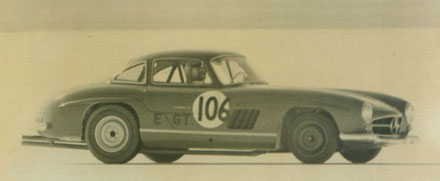
The Alloy Car
It wasn’t until nearly a decade later that Don decided to take on the salt.
“I had an aluminum car that I’d bought off Bob Frentress in May 1966. The engine had been reworked by Lothar Motsenbacher, and when I was finished with it the displacement was 201 cu. in. Jerry Fairchild came into the picture about that time. We were old motorcycle buddies, went to school together, grew up together, and he said, ‘We ought to get that thing up to Bonneville and see what it will do.’ Jerry balanced the crankshaft, pistons, rods, clutch, and flywheel, we got the car together, and we trailered it to Bonneville in 1967.”
The modified engine displaced 584.95 cc per cylinder, for 3,293.7 cc total. The block had been bored “80 over” to 3.438 inches; the crank was hard chrome-plated and stroked 0.155-in to 3.610 in. ForgedTrue pistons with 10.98:1 compression accommodated the high-lift cam and were fitted with special Grant rings. The Bosch mechanical fuel-injection was re-tuned, and Bosch transistor ignition was installed with a special Bosch dual-point distributor. Twin 10-ft straight exhaust pipes were added, and the underside of the car was slickened with an aluminum belly pan. The suspension was fitted with Koni shocks, and the tires were swapped for Firestone Bonnevilles, 5.50-15 front and 6.70-15 rear. The only stock mechanical pieces left were the transmission, driveshaft, and 3.25:1 rear axle.
On the Salt
With the number 106 on the car, Don was ready to risk his life to triumph over speed, time, and distance. On the first day he made a practice run on the back course, but to everyone’s dismay the car would do no more than 120 mph.
“After all that work to tune it, we couldn’t figure out what was wrong. When I got it back to the pits we started going over everything, and what did we find? The bolts in the firewall that hold the foot throttle were missing, so I hadn’t been able to fully depress the pedal! Once we got it bolted down, I went back out and made a run at 150.”
The next day, during his first timed run, Don was just hitting 150 mph when he heard a loud crash, “like a sonic boom. As I got my wits together I realized that my driver’s door had come unlatched and flown open. The car raised up on two wheels, and people told me later it was at least six to eight inches off the ground. That was a real thrill,” he says with the same sense of ease that must have prevailed upon him that day.
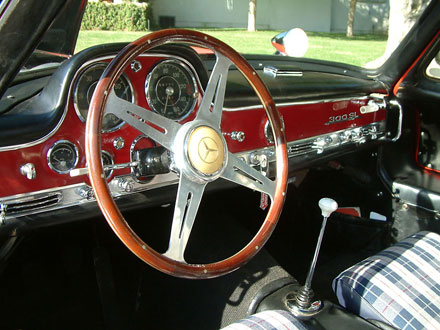
“I got it down without incident and drove back to the staging area, where they thought the car had exploded. They told me that from the finish line it looked like the engine had blown and the front of the car had come off! ‘No,’ I said, ‘the door just came open.’ Everyone was amazed that I held the car straight and didn’t try to brake or come off the throttle too quickly. If I had, I’d be rolling yet out there.”
Word got around the pits that Ricardo had driven the car on two wheels at 150 mph, and that would have been the feat of the day had it not been for another driver who spun on course and went through the timing traps backward at 208 mph!s
“It has always amazed me that the door held; it went over the stop and creased the roof. That gullwing door has to be one of the greatest pieces of machinery that Mercedes-Benz or anybody has ever made.”
Ricardo returned to Bonneville three more times to try and break his own record but never succeeded. Nor has anyone else. The record still stands for that size engine in a 300SL.
